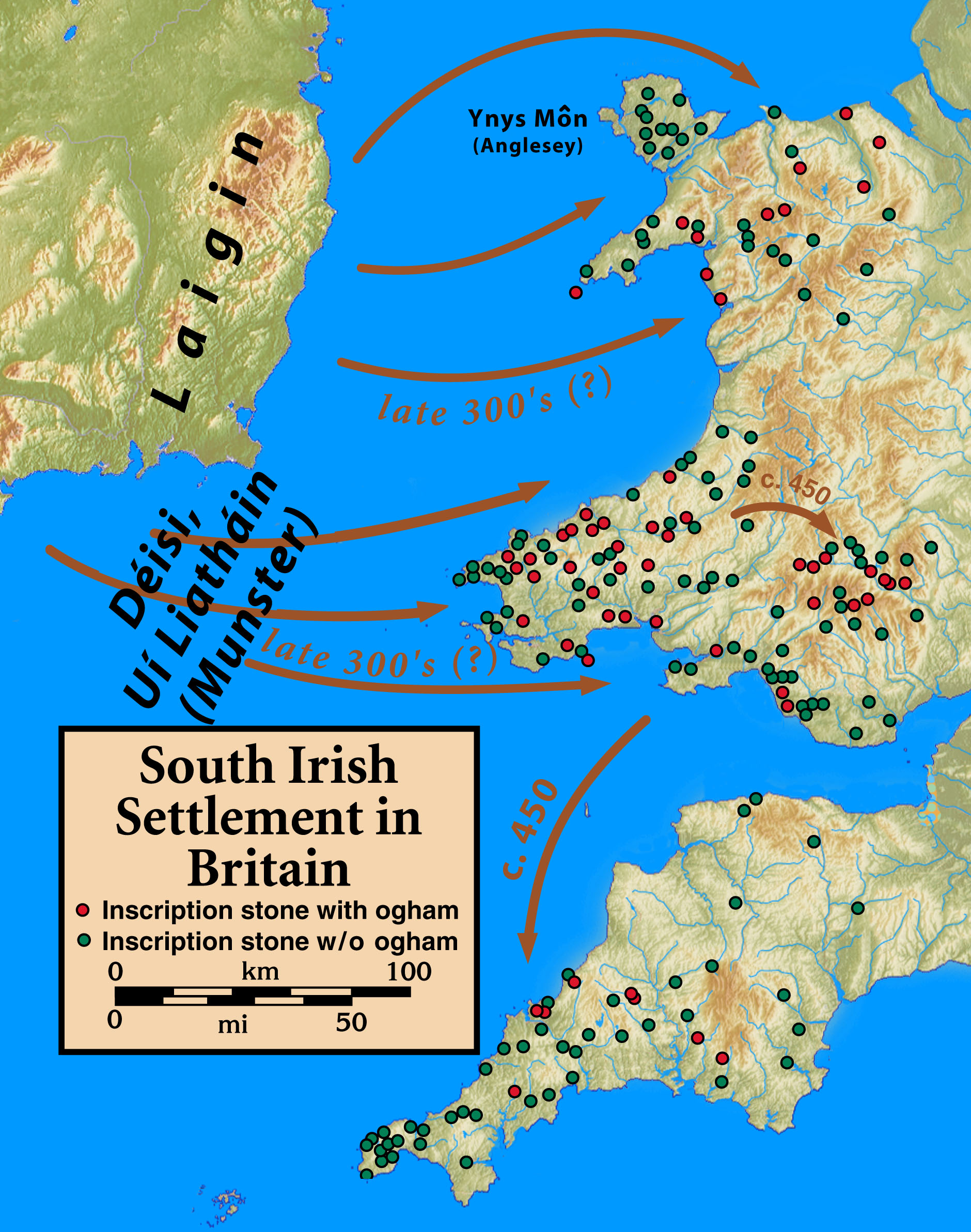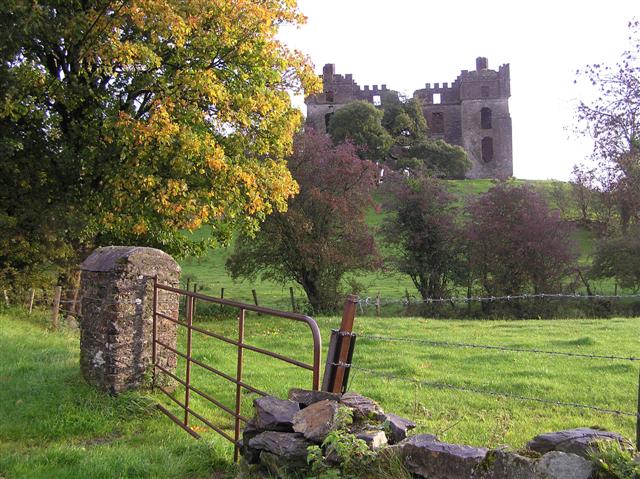|
Magh Ithe
Mag Itha, Magh Ithe, or Magh Iotha was, according to Irish mythology, the site of the first battle fought in Ireland. Medieval sources estimated that the battle had taken place between 2668 BCE and 2580 BCE (''Anno Mundi'' 2530 or 2618). The opposing sides comprising the Fomorians, led by Cichol Gricenchos, and the followers of Partholón. According to the ''Lebor Gabála Érenn'', the Fomorians had lived in Ireland for 200 years, subsisting by fishing and fowling, before the arrival of Partholón, whose people were the first in Ireland to build houses and brew ale. The ''Lebor Gabála'' dates Partholón's arrival in Ireland to AM 2608 (2590 BCE), and says the Battle of Mag Itha took place ten years later, in AM 2618 ( circa 2580 BCE). The plain of Mag Itha is said to have been cleared by Partholón's hireling Ith, and the battle to have taken place on the ''slemna'', or "smooth lands", of that plain. 300 Fomorians took part in the battle, and Partholón was victorious. The earlie ... [...More Info...] [...Related Items...] OR: [Wikipedia] [Google] [Baidu] |
Irish Mythology
Irish mythology is the body of myths native to the island of Ireland. It was originally passed down orally in the prehistoric era, being part of ancient Celtic religion. Many myths were later written down in the early medieval era by Christian scribes, who modified and Christianized them to some extent. This body of myths is the largest and best preserved of all the branches of Celtic mythology. The tales and themes continued to be developed over time, and the oral tradition continued in Irish folklore alongside the written tradition, but the main themes and characters remained largely consistent. The myths are conventionally grouped into ' cycles'. The Mythological Cycle consists of tales and poems about the god-like Túatha Dé Danann, who are based on Ireland's pagan deities, and other mythical races like the Fomorians. Important works in the cycle are the ''Lebor Gabála Érenn'' ("Book of Invasions"), a legendary history of Ireland, the ''Cath Maige Tuired'' ("Ba ... [...More Info...] [...Related Items...] OR: [Wikipedia] [Google] [Baidu] |
Irish Battles
This is a list of conflicts in Ireland, including wars, armed rebellions, battles and skirmishes. Irish Warriors participated in many wars in Europe and “England” as well and are not completely recognized on this page. List of wars and rebellions in Ireland List of battles in Ireland Prehistoric era 5th century *459 – Ath Dara *464 – First Battle of Dumha Aichir *468 – Bri Ele *470 – Second Battle of Dumha Aichir *476 – First Battle of Granard *478 – Ocha *480 – Second Battle of Granard *483 – Battle of Ochae *489 – Tailtin *491 – Cell Losnaid *492 – Sleamhain, in Meath *493 – Battle for the Body of St. Patrick *494 – Ceann Ailbhe *496 – Druim Lochmaighe *497 – Inde Mor, in Crioch Ua nGabhla *499 – Seaghais 6th century *500 – Lochmagh *501 – Freamhain, in Meath *506 – Luachair *507 – Druim Deargaighe *528 – Luachair *531 – Claenloch *537 – Sligeach *544 – Cuil Conaire *546 – Cuilne *556 – Cuil U ... [...More Info...] [...Related Items...] OR: [Wikipedia] [Google] [Baidu] |
History Of Ireland
The first evidence of human presence in Ireland dates to around 33,000 years ago, with further findings dating the presence of homo sapiens to around 10,500 to 7,000 BC. The receding of the ice after the Younger Dryas cold phase of the Quaternary around 9700 BC, heralds the beginning of Prehistoric Ireland, which includes the archaeological periods known as the Mesolithic, the Neolithic from about 4000 BC and the Copper Age beginning around 2500 BC with the arrival of the Beaker Culture. The Irish Bronze Age proper begins around 2000 BC and ends with the arrival of the Iron Age of the Celtic Hallstatt culture, beginning about 600 BC. The subsequent La Tène culture brought new styles and practices by 300 BC. Greek and Roman writers give some information about Ireland during the Classical period (see "protohistoric" period), by which time the island may be termed "Gaelic Ireland". By the late 4th century AD Christianity had begun to gradually subsume or replace the earlier Celtic ... [...More Info...] [...Related Items...] OR: [Wikipedia] [Google] [Baidu] |
Déisi
The ''Déisi'' were a socially powerful class of peoples from Ireland that settled in Wales and western England between the ancient and early medieval period. The various peoples listed under the heading ''déis'' shared the same status in Gaelic Ireland, and had little or no actual kinship, though they were often thought of as genetically related. During the Early Middle Ages some Déisi groups and subgroups exerted great political influence in various parts of Ireland, and certain written sources suggest a connection to Britain as well. During early medieval Munster, the Déisi were under the hegemony of the Eoganachta confederacy. Etymology Déisi is an Old Irish term that is derives from the word ''déis'', which meant in its original sense a "vassal" or "subject", a designated group of people who were rent-payers to a landowner.Ó Cathasaigh, pp. 1-33. Later, it became a proper noun for certain septs and their own subjects throughout Ireland.MacNeill, pp. 1-41. History and ... [...More Info...] [...Related Items...] OR: [Wikipedia] [Google] [Baidu] |
County Wicklow
County Wicklow ( ; ga, Contae Chill Mhantáin ) is a county in Ireland. The last of the traditional 32 counties, having been formed as late as 1606, it is part of the Eastern and Midland Region and the province of Leinster. It is bordered by the Irish Sea to the east and the counties of Wexford to the south, Carlow to the southwest, Kildare to the west, and South Dublin and Dún Laoghaire–Rathdown to the north. Wicklow is named after its county town of Wicklow, which derives from the name (Old Norse for "Vikings' Meadow"). Wicklow County Council is the local authority for the county, which had a population of 155,258 at the 2022 census. Colloquially known as the "Garden of Ireland" for its scenerywhich includes extensive woodlands, nature trails, beaches, and ancient ruins while allowing for a multitude of walking, hiking, and climbing optionsit is the 17th largest of Ireland's 32 counties by area and the 15th largest by population. It is also the fourth largest of Lein ... [...More Info...] [...Related Items...] OR: [Wikipedia] [Google] [Baidu] |
Arklow
Arklow (; ; , ) is a town in County Wicklow on the southeast coast of Ireland. The town is overlooked by Ballymoyle Hill. It was founded by the Vikings in the ninth century. Arklow was the site of one of the bloodiest battles of the 1798 rebellion. Its proximity to Dublin led to it becoming a commuter town with a population of 13,163 as of the 2016 census. Arklow is at the mouth of the River Avoca, the longest river wholly within County Wicklow. The town is divided by the river, which is crossed by the Nineteen Arches Bridge, a stone arch bridge linking the southern or main part of the town with the northern part, called Ferrybank. The Nineteen Arches Bridge is the longest handmade stone bridge in Ireland, and a plaque on the south end of the bridge acknowledges this. History The town's English name derives from ''Arnkell's Lág'' (Arnkell was a Viking leader; a "lág" (low) was an area of land). Its Irish name, ''Inbhear Mór'' or ''An tInbhear Mór'', means ''the large ... [...More Info...] [...Related Items...] OR: [Wikipedia] [Google] [Baidu] |
Raphoe
Raphoe ( ; ) is a historical village in County Donegal, Ireland. It is the main town in the fertile district of East Donegal known as the Laggan, as well as giving its name to the Barony of Raphoe, which was later divided into the baronies of Raphoe North and Raphoe South, as well as to the Roman Catholic Diocese of Raphoe and the Church of Ireland (Anglican) Diocese of Derry and Raphoe. The Burn Dale (also known in English as the Burn Deele) is a ''burn (landform), burn'' (a small river) that flows a short distance to the south of Raphoe. The Burn Dale eventually flows, via the village of Ballindrait, into the River Foyle just north of Lifford. Name ''Raphoe'', historically ''Raffoe'',Placenames Database of Ireland (see archival records) comes from the Irish Language, Irish ''Ráth Bhoth'', which is made up of the words ''ráth'' ... [...More Info...] [...Related Items...] OR: [Wikipedia] [Google] [Baidu] |
Lough Swilly
Lough Swilly () in Ireland is a glacial fjord or sea inlet lying between the western side of the Inishowen, Inishowen Peninsula and the Fanad Peninsula, in County Donegal. Along with Carlingford Lough and Killary Harbour it is one of three glacial fjords in Ireland. Geography and ecology Located on the Fanad Peninsula, in County Donegal, the northern extremities of the lough are marked by Fanad, Fanad Head with its lighthouse and Dunaff Head. Towns situated on the lough include Buncrana on Inishowen and Rathmullan on the western side. At the southern end of the lough lies Letterkenny. In the south of the lough a number of islands (Burt, Inch Island, Inch, Coney, Big Isle) were poldered and the land reclaimed during the 19th century for agriculture and the Londonderry and Lough Swilly Railway constructed embankments on the line from Derry to Letterkenny. These reclaimed lands are now wetlands associated with wildlife conservation and birdwatching, and support over 4,000 whooper s ... [...More Info...] [...Related Items...] OR: [Wikipedia] [Google] [Baidu] |
River Finn (County Donegal)
The River Finn ( ga, Abhainn na Finne) is a river in the Republic of Ireland that passes through County Donegal and County Tyrone in Northern Ireland. From Lough Finn, the river goes to Ballybofey and Stranorlar before joining the River Mourne. The Monellan Burn, also known as the Creamery Burn, flows into the River Finn very near a hamlet called The Cross, not far from the former site of Monellan Castle, just outside Killygordon. From Castlefin downstream, the river is tidal, becoming deeper towards Strabane. The Finn is long and together with its tributary the Reelin River, drains a catchment area of 195 square miles. The River Foyle is formed by the confluence of the River Mourne and the River Finn, west of Lifford Bridge. The area which the River Finn flows through is called the Finn Valley. The village of Clady, near Strabane in County Tyrone, is on the River Finn. The football club in Ballybofey, Finn Harps, is named after the river. Angling The upper reaches of th ... [...More Info...] [...Related Items...] OR: [Wikipedia] [Google] [Baidu] |
John O'Donovan (scholar)
John O'Donovan ( ga, Seán Ó Donnabháin; 25 July 1806 – 10 December 1861), from Atateemore, in the parish of Kilcolumb, County Kilkenny, and educated at Hunt's Academy, Waterford, was an Irish language scholar from Ireland. Life He was the fourth son of Edmond O'Donovan and Eleanor Hoberlin of Rochestown. His early career may have been inspired by his uncle Parick O'Donovan. He worked for antiquarian James Hardiman researching state papers and traditional sources at the Public Records Office. Hardiman had secured O'Donovan a place in Maynooth College which he turned down. He also taught Irish to Thomas Larcom for a short period in 1828 and worked for Myles John O'Reilly, a collector of Irish manuscripts. Following the death of Edward O'Reilly in August 1830, he was recruited to the Topographical Department of the first Ordnance Survey of Ireland under George Petrie in October 1830. Apart from a brief period in 1833, he worked steadily for the Survey on place-name resea ... [...More Info...] [...Related Items...] OR: [Wikipedia] [Google] [Baidu] |
.jpg)






